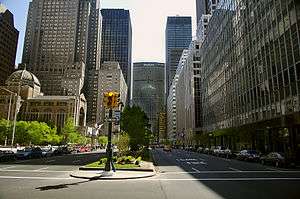Park Avenue
|
A view down Park Avenue facing the MetLife Building and the Waldorf Astoria hotel to the left. | |
| Other name(s) | Fourth Avenue, Union Square East, Park Avenue South |
|---|---|
| Former name(s) | Fourth Avenue |
| Owner | City of New York |
| Maintained by | NYCDOT |
| Length | 10.9 mi[1][2][3] (17.5 km) |
| Location | Manhattan and The Bronx, New York City |
| South end | Astor Place in Cooper Square |
| Major junctions |
Park Avenue Tunnel and Viaduct in East Midtown |
| North end | Third Avenue in Fordham |
| East | Lexington Avenue |
| West | Madison Avenue |
| Construction | |
| Commissioned | March 1811 |
Park Avenue is a wide New York City boulevard[4] which carries north and southbound traffic in the borough of Manhattan, and is also a wide one-way pair in the Bronx. For most of the road's length in Manhattan, it runs parallel to Madison Avenue to the west and Lexington Avenue to the east. Park Avenue's entire length was formerly called Fourth Avenue; the title still applies to the section between the Bowery and 14th Street.[5] Meanwhile, the section between 14th and 17th Street is called Union Square East, and between 17th and 32nd Streets, the name Park Avenue South is used. In the Bronx, Park Avenue runs in several segments between the Major Deegan Expressway and Fordham Road.[6]
History

Park Avenue was originally known as Fourth Avenue and carried the tracks of the New York and Harlem Railroad starting in the 1830s.[7] The railroad originally ran through an open cut through Murray Hill, which was covered with grates and grass between 34th and 40th Street in the early 1850s. A section of this "park" was later renamed Park Avenue in 1860, which was afterwards applied to the area leading up to 42nd Street.[8] When Grand Central Depot was opened in the 1870s, the railroad tracks between 56th and 93rd Streets were sunk out of sight and, in 1888, Park Avenue was extended to north of Grand Central.[9]
In 1936 the elevated Park Avenue Viaduct was built around the station to allow automobile traffic to pass unimpeded. In October 1937, a part of the Murray Hill Tunnel was reopened for road traffic. Efforts to promote a Grand Park Avenue Expressway to Grand Concourse in the Bronx were unavailing.[10]
A tradition was introduced in 1945 as a memorial to American soldiers killed in action, whereby Christmas trees are placed in the median section each December.[11]
On May 5, 1959, the New York City Council voted 20–1 to change the name of Fourth Avenue between 17th and 32nd Streets to Park Avenue South.[12] In 1963, the Pan Am Building, straddling Park Avenue atop Grand Central Terminal, was built between the automotive viaducts.
On March 12, 2014, two apartment buildings near 116th Street, 1644 and 1646 Park Avenue, were destroyed in a gas explosion. Eight people were killed and many others were injured.[13]
Route
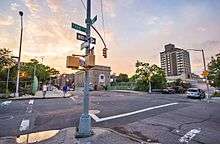
The road that becomes Park Avenue originates as the Bowery. From Cooper Square at 8th Street to Union Square at 14th Street, it is known as Fourth Avenue, a 70-foot-wide (21 m) road carrying northbound traffic. At 14th Street, it turns slightly northeast to align with other avenues drawn up in the Commissioners' Plan of 1811. From 14th Street to 17th Street, it forms the eastern boundary of Union Square and is known as Union Square East; its southbound lanes merge with Broadway south of 15th Street, and the thoroughfare divides into two distinct portions in the one-block section between 14th and 15th Streets. From 17th Street to 32nd Street, it is known as Park Avenue South. Above 32nd Street, for the remainder of its distance, it is known as Park Avenue, a 140-foot-wide boulevard.
Between 33rd Street and 40th Street, the left-hand northbound lane descends into the Murray Hill Tunnel. Immediately across from 40th Street, the center lanes of Park Avenue rise onto an elevated structure that goes around Grand Central Terminal and the MetLife Building (formerly the PanAm Building), carrying each direction of traffic on opposite sides of the buildings. The bridge, one of two structures in Manhattan known as the Park Avenue Viaduct, returns to ground level at 46th Street after going through the Helmsley Building (also referred to as the New York Central Building or 230 Park Avenue). The IRT Lexington Avenue Line runs under this portion of the street. Once the line reaches Grand Central – 42nd Street, it shifts east to Lexington Avenue.
As Park Avenue enters Midtown north of Grand Central Terminal, it is distinguished by many glass-box skyscrapers that serve as headquarters for corporations such as JPMorgan Chase at 270 Park Avenue and 277 Park Avenue, UBS at 299 Park Avenue, Citigroup, Colgate-Palmolive, and MetLife at the MetLife Building. Prior to July 2010, the eleven intersections between 46th Street and 56th Street were without the city's usual pedestrian crossing signals and overhead gantry-mounted traffic lights because the railroad tunnel ceiling, which is also the street, was not thick enough for their poles' foundations. (These intersections did, however, have upright pole-mounted traffic lights prior to 2010, but there were no pedestrian signals. After 2010, standard gantry-mounted traffic lights and pedestrian "countdown" signals were installed.)[14][15]
From 47th to 97th Streets, Metro-North Railroad tracks run in a tunnel underneath Park Avenue (the Park Avenue Tunnel). In the 1920s the portion of Park Avenue from Grand Central Terminal to 96th Street saw extensive apartment building construction. This long stretch of the avenue contains some of the most expensive real estate in the world. Real estate at 740 Park Avenue, for example, sells for several thousand dollars per square foot.[16] Current and former residents in this stretch of the thoroughfare include Blackstone Group co-founder Stephen Schwarzman, former Morgan Stanley executive Zoe Cruz, private equity investor Ronald O. Perelman, John D. Rockefeller Jr., Vera Wang, and others. James Cash Penney lived at 888 and Leonard Bernstein at 898.
At 97th Street, the tracks come above ground, rising onto the other Manhattan structure known as the Park Avenue Viaduct. The first street to pass under the viaduct is 102nd Street; from there to the Harlem River the railroad viaduct runs down the middle of Park Avenue. Park Avenue in Manhattan ends north of 132nd Street, with connections to the Harlem River Drive. The avenue is continued on the other side of the river in the Bronx. In the Bronx, Park Avenue begins at East 135th Street in the Mott Haven neighborhood. The entire avenue is divided by Metro-North's own right of way in the borough. Between East 135th Street to East 173rd Street, Park Avenue is one way only in ether direction in most sections. North of East 173rd Street it is a two way avenue continuing to Fordham Plaza where it ends.
The flowers and greenery in the median of Manhattan's Park Avenue are privately maintained, by the Fund for Park Avenue. The begonia was specifically chosen by the Fund's gardeners because there is no automatic watering system and the floral variety is resilient under hot sun rays.[17]
Businesses
The following institutions are either headquartered or have significant business presences on Park Avenue:
|
|
|
Notable structures
In numerical order:
- 3 Park Avenue
- Scandinavia House, 58 Park Avenue
- Pershing Square Building, 125 Park Avenue
- Grand Central Terminal (actually in Park Avenue, between the Park Avenue Viaduct's two roadways)
- MetLife Building, 200 Park Avenue
- Helmsley Building, 230 Park Avenue
- 245 Park Avenue
- 270 Park Avenue
- 277 Park Avenue
- 299 Park Avenue
- Waldorf Astoria New York, 301 Park Avenue
- 345 Park Avenue
- 399 Park Avenue
- 432 Park Avenue
- Halstead Property, 499 Park Avenue
- Central Presbyterian Church, 593 Park Avenue
- 620 Park Avenue
- Harold Pratt House, 58 East 68th Street (corner of Park Avenue)
- Park Avenue Houses
- Percy R. Pyne House, 680 Park Avenue (now the Americas Society)
- Oliver D. Filley House, 684 Park Avenue (now the Queen Sofía Spanish Institute)
- William Sloane House, 686 Park Avenue (now the Italian Cultural Institute of New York)
- Henry P. Davison House, 690 Park Avenue (now the Italian Consulate General)
- Asia Society, 725 Park Avenue
- 740 Park Avenue
- 970 Park Avenue
- Church of St. Ignatius Loyola (New York City), 980 Park Avenue
- 1000 Park Avenue
- Park Avenue Christian Church, 1010 Park Avenue
In popular culture
- Will Smith, as a policeman, pursues a criminal by jumping off the Park Avenue Viaduct in the 1997 film Men in Black.
- In the 1988 film Cocktail, Tom Cruise visits the wealthy father of Elizabeth Shue's character, Jordan, who lives on Park Avenue at 67th street.
- In the 2007 film I Am Legend, Will Smith again appears on the Park Avenue Viaduct, where his character is captured by a vampire's snare.
- In the 2012 film The Avengers, the climax takes place on the Park Avenue Viaduct.
- On the TV series The Odd Couple, Felix Unger and Oscar Madison live at 1049 Park Avenue.
- On the TV series Diff'rent Strokes, Phillip Drummond, with his daughter, Kimberly and adopted sons, Willis and Arnold Jackson live at 697 Park Avenue.
- The PBS documentary Park Avenue: Money, Power and the American Dream sheds light on the gap between the impoverished people living on Park Avenue in the South Bronx and the extremely wealthy living at 740 Park Avenue in Manhattan.
- In the song "Youth Gone Wild" by American band Skid Row, Park Avenue is mentioned in the lyrics: "I said 'Hey man, there's something that you oughta know. / I tell ya Park Avenue leads to Skid Row.'"
- The stage and film musical How to Succeed in Business Without Really Trying takes place in the fictional "Park Avenue office building of World Wide Wicket Company, Inc."
- The street lent its name to the Buick Park Avenue, a large luxury sedan that was produced from 1977 to 2005.
- In the intro to the late 1960s - early 1970s TV show Green Acres, Eva Gabor's character sings "Darling I love but give me Park Avenue!", where she lived before moving to rural Hooterville with her husband, the lawyer-turned-farmer.[18]
Gallery
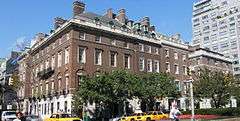 Henry P. Davison House, Percy Rivington Pyne House, Oliver D. Filley House and William Sloane House is one of the original house ensembles left on Park Avenue
Henry P. Davison House, Percy Rivington Pyne House, Oliver D. Filley House and William Sloane House is one of the original house ensembles left on Park Avenue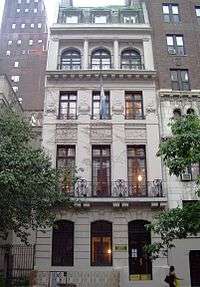 The Adelaide L. Townsend Douglas House, currently the Guatemalan U.N. Mission at 57 Park Avenue, between East 37th and 38th Streets
The Adelaide L. Townsend Douglas House, currently the Guatemalan U.N. Mission at 57 Park Avenue, between East 37th and 38th Streets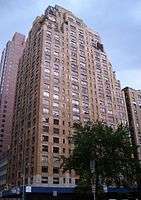 10 Park Avenue, at the corner of East 34th Street
10 Park Avenue, at the corner of East 34th Street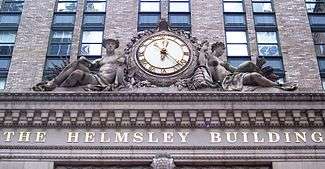 230 Park Avenue, the Helmsley Building
230 Park Avenue, the Helmsley Building
See also
References
Notes
- ↑ Google (September 10, 2015). "Fourth Avenue and Union Square East" (Map). Google Maps. Google. Retrieved September 10, 2015.
- ↑ Google (September 10, 2015). "Park Avenue (Manhattan)" (Map). Google Maps. Google. Retrieved September 10, 2015.
- ↑ Google (September 10, 2015). "Park Avenue (The Bronx)" (Map). Google Maps. Google. Retrieved September 10, 2015.
- ↑ Gray, Christopher (May 12, 2002). "Streetscapes:903 Park Avenue, at 79th Street". The New York Times.
- ↑ New York City Geographic Information Systems map
- ↑ New York City Geographic Information Systems map.
- ↑ Gray, Christopher (March 3, 2013). "Before There Was a 'Grand' in Central". The New York Times. Retrieved October 15, 2015.
- ↑ Gray, Christopher (July 24, 2011). "Putting the Park in Park Avenue". The New York Times. Retrieved October 15, 2015.
- ↑ Gray, Christopher (March 17, 2002). "Streetscapes: 709 and 711 Park Avenue, Between 69th and 70th Streets; When Park Ave. Was 4th, and Not Socially Correct". The New York Times. Retrieved October 15, 2015.
- ↑ "Park Avenue Express Highway (NY 22, unbuilt)". Nycroads.com. February 14, 1935. Retrieved October 8, 2012.
- ↑ Kilgannon, Corey (December 3, 2010). "Park Ave. Christmas Lights Go Up, and Xiao Ye Closes". The New York Times.
- ↑ Charles G., Bennett (May 6, 1959). "Sign Ban Is Voted on Two Avenues". The New York Times. p. 41. Retrieved July 31, 2010.
- ↑ Santora, Marc & Rashbaum, William K. "Rescue Effort in East Harlem Yields Only More Victims". New York Times. Retrieved 13 March 2014.
- ↑ Neuman, William (September 22, 2007). "It's a Deal: Help for Park Ave. Pedestrians". The New York Times. Retrieved February 24, 2012.
- ↑ Goodman, Jillian; Rovzar, Chris (July 7, 2010), "City Finally Installs Crossing Signals on Park Avenue Above Grand Central", New York, retrieved February 24, 2012
- ↑ Rogers, Teri Karush (October 9, 2005). "Peeking Behind the Gilded Walls of 740 Park Ave.". The New York Times. Retrieved August 15, 2007.
- ↑ Pollak, Michael (July 16, 2006). "Why Yellow Takes the Wheel". The New York Times. Retrieved July 31, 2010.
- ↑ [video|url=https://www.youtube.com/watch?v=DrbPAt1_vc4]
External links
| Wikimedia Commons has media related to Park Avenue. |
- New York Songlines: Fourth Avenue with The Bowery and Park Avenue, a virtual walking tour
- Classic Apartments Buildings and Architecture of Park Avenue Images & History
